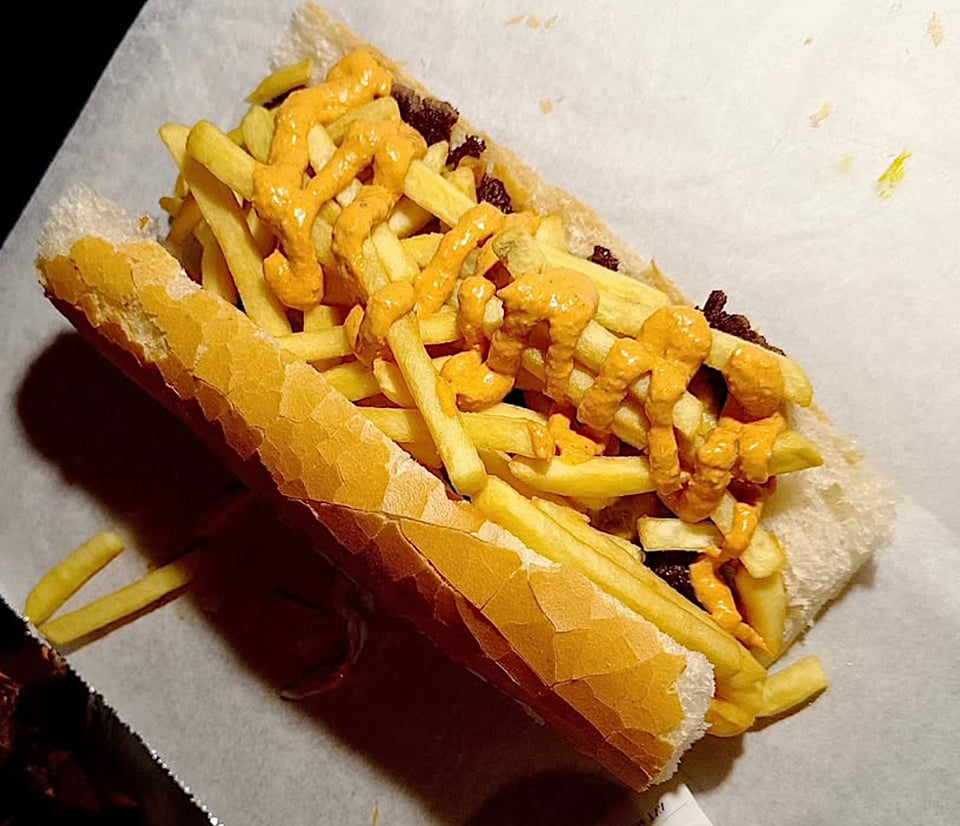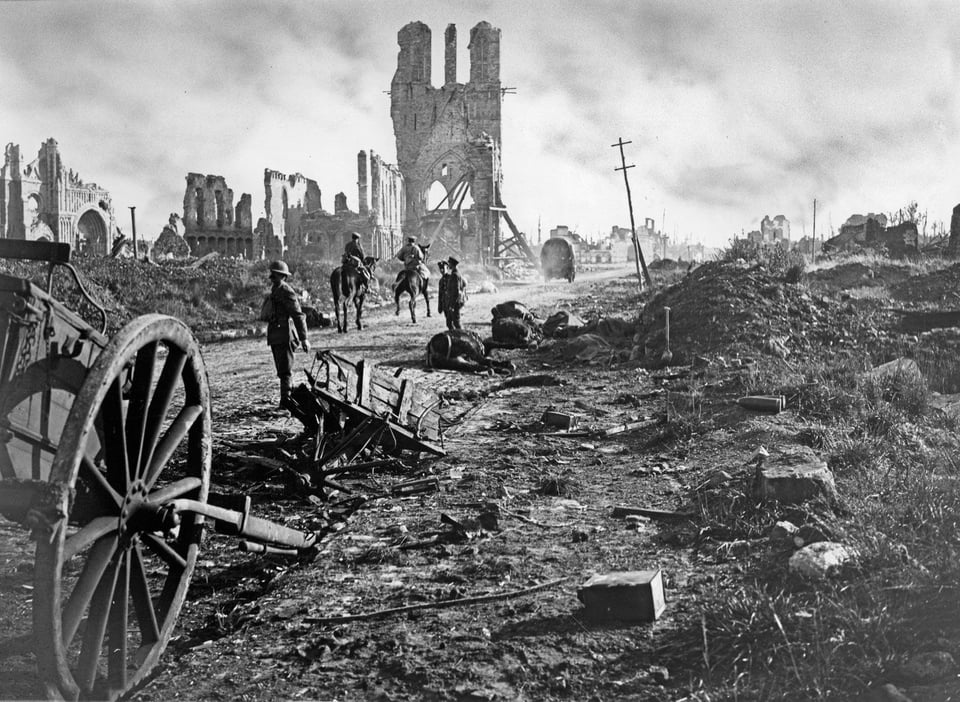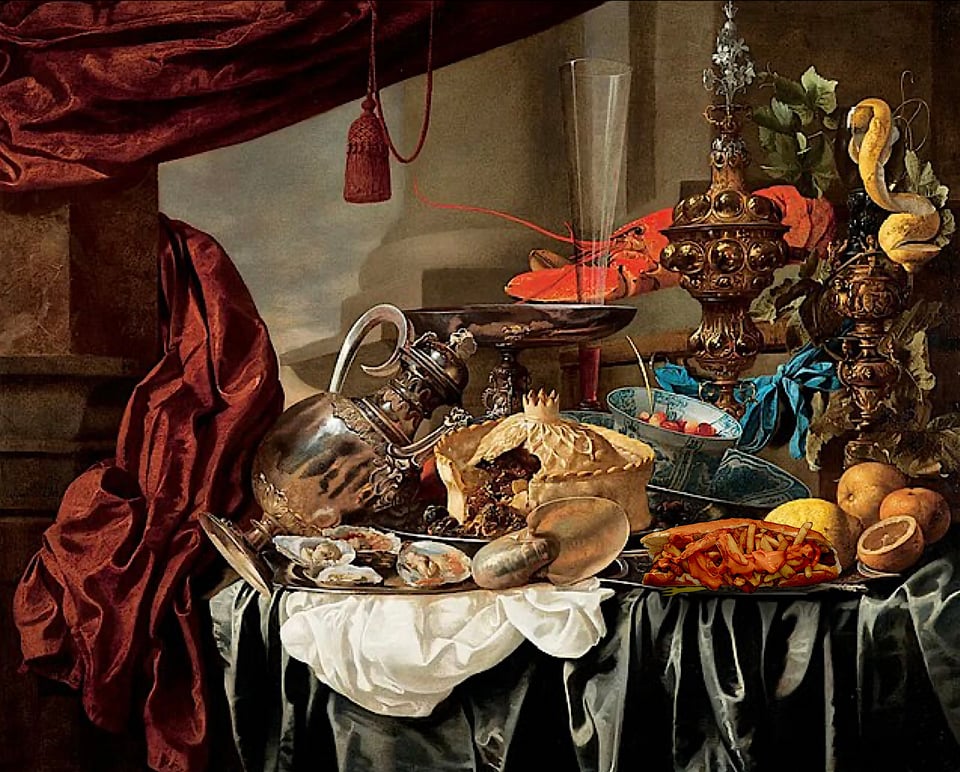Notable Sandwiches #118: Mitraillette

Welcome back to Notable Sandwiches, the feature where I, alongside my editor David Swanson, dodge and weave our way through the charnel-house that is Wikipedia’s List of Notable Sandwiches, in alphabetical order. This week, a Belgian treat: the mitraillette.

Once again, in confronting a Notable Sandwich, I’m also confronted with a dubious—and perhaps, untraceable—origin story.
This isn’t the first such orphan fact we’ve covered here. Far from it, in fact. Culinary history is full of unsourced myth-making, the kitchen being nearly as convenient as the barnyard for the manufacture of bullshit. I suppose the reason for my particular frustration about this Belgian sandwich’s elusive origin is that, frankly, its appeal seems elusive, too.
The mitraillette is a baguette full of fries—so far, so Belgian, I suppose, given that nation’s claim to have invented the frite—plus some meat (dealer’s choice), some sauce, and whatever other accouterments your restaurateur sees fit to adorn it with. The name means “submachine gun.” Its other popular nickname, from the French side of the Belgian border, is l’américain—the American—perhaps because of our association with guns, or perhaps because it is a large, indulgent, and calorific meal, such as we Americans tend to guzzle like hogs.
This sandwich seems tolerable (fries in sandwiches have always seemed an unnecessarily stodgy combination to me, but additional grease and salt never hurt a drunk-food staple). The result may not be particularly exciting, but then, standards like moules frites and sugar-dusted waffles aside, Belgium probably isn’t the country you’re looking for when you think of cutting-edge cuisine.

Anyway, the origin story for the mitraillette is contested, which is a polite way of saying the extant tales that pillbox this sandwich seem dubious as hell to me. Focus on Belgium, a publication that seems to be affiliated with the Belgian ministry of foreign affairs, claims that it originated roughly a century ago—so, after Belgium was thoroughly ravaged in World War I in unimaginable horrors that have literally scarred its landscape, but before it was similarly ravaged in World War II. “This typically Belgian dish was created during the interwar period. When it was hard to make ends meet every month, or the soldiers did not have many provisions, they just ate bread with a few fries,” claims the un-bylined piece, helpfully entitled “Did you know that the mitraillette originated in the interwar period?”
This event is “said” to have happened in the Charleroi area, in the region of Wallonia. (Others have pointed out that Wallonia is where international arms manufacturer FN Herstal was established in 1889, just in time to supply the brutal conquest of the Belgian Congo.) There’s no evidence of this bread-and-fries agglomeration being the invention or exclusive province of Wallonian soldiers, and, at any rate, the sandwich in its current form didn’t emerge for another fifty years or so. As Focus on Belgium points out, “The mitraillette as we know it today appeared with the arrival of the French baguette, which was produced in Belgium from 1975-76.”
(Bad phrasing aside—you can certainly obtain a baguette in Belgium right now; that didn’t stop in 1976—it is worth noting that the baguette was only invented in 1839, in France, and not industrially produced until the 1920s. As tempting as it is to imagine Medieval French peasants lugging around long loaves, commercial ovens with steam injectors were what enabled that famous crust to form. I still think that’s just neat and implausible, like ciabatta bread being invented in the 1980s! It’s unclear why the Belgian government claims a fifty-year gap between the mass production of the baguette in France and its appearance in Belgium, given that the two countries are neighbors. Just another culinary mystery.)
The Sword and the Sandwich is a newsletter about deadly serious extremism and serious sandwiches. Please consider supporting this work with a paid subscription.
At any rate, the myth of the starving Walloons eating fries in their baguettes persists throughout most accounts of the mitraillette’s origin, despite there being absolutely no evidence cited for it and the parties involved being conveniently anonymous. In publication after publication this tale endures, each account plagiarizing the other, no one citing, no one quoting a primary source, just skating on by on regurgitation.
The proliferation of such orphan facts (which are often disprovable!) throughout culinary history has made me question the nature of information itself, and wonder how many such breezy legends, spun out of nothing more than the desire to create some sort of compelling and specific narrative, are larded throughout other more ostensibly important disciplines—national histories, military histories, histories of peoplehood. In any case, it’s not like food is so readily extricable from any of the former categories. By far my favorite unsourced-bullshit myth about the mitraillette comes by way of storied food magazine Saveur: “It’s said,” writes Meredith Bethune, “that the thick and chewy baguette represents the barrel of the gun, while the still-warm fries stand in for the bullets.” Listen, if you’re going to make something up (or at least spread unattributed information), do it with panache.
But looking around the truly dire state of the information landscape of 2024, it’s hard not to get a little grim at the mouth. So much of the purportedly reliable information peddled to us is as stale and worthless as a two-day-old baguette. Or, as Dutch actor Rutger Hauer might have put it: All this bullshit will be lost, in time… Like a sandwich in the rain.

Made fresh off the griddle, the mitraillette/américain is very much listed as one of Belgium’s favorite delicacies, and is apparently ubiquitous at doner-kebab shops, where they insert shawarma into the baguette. You can get it with sauce andalouse, a mayonnaise-and-roast-red-pepper concoction that actually sounds pretty tasty. All in all, it seems like a decent way for the impecunious and/or wasted to fill up cheaply. Still, looking at yet another government source, it’s hard not to think that of all Belgium’s culinary offerings, the mitraillette is a pale, constipation-causing shadow of other specialties. In its section on Belgian gastronomy, belgium.be offers this encomium:
“Traditional Belgian dishes are hearty: rabbit cooked in Gueuze, Flemish beef stew, waterzooi with chicken or fish, stewed eel in a green herb sauce, a meat roulade dish called ‘headless birds’, chicons au gratin, ‘américain’ with fries… There are so many delicious dishes, with occasionally strange names, to discover and savour. Afterwards, you can taste one of many Belgian cheeses, you will be surprised by their quality and diversity.”
I would like to be surprised by cheese diversity, by headless birds. To this sandwich, built on myths and cheap carbohydrates, I offer little but my scorn.
I’d probably still eat it while very drunk, though.
A bientot! Or as they say it in Walloon, A rvey, mi sonk eyet oxhea!

-
Bravo! A tour de force, once again. Great having you back.
-
As well as chip butties (mentioned already!) in Scotland you can get a tattie scone roll.
A tattie - potato - scone is a sort of triangular unleavened bread made with potatoes and some flour, butter and salt. https://en.m.wikipedia.org/wiki/Tattie_scone
The roll is typically slightly chewy with a squarish shape https://en.m.wikipedia.org/wiki/Morning_roll
-
We went to Belgium as part of our honeymoon (everyone thought we were Canadian because what Americans go to Belgium?). I can attest to how freaking good the food was there. Plus the beer and chocolate. The slightly fancier stuff is a neat mix of French and German cuisine. We're both dying to go back over a decade later.
-
Adding shawarma into the thing is a different kettle of fish, as would adding fish itself! It seems nothing so much as an unfinished sandwich, begging one more ingredient, at least, to complete it.
But a fun read, indeed. Good to see/read you again! ~P
-
Dang, and here I thought Pittsburgh was to blame for fries on sammiches....
-
I thought that fries on a sandwich was only a Pittsburgh thing, also from a probably apocryphal story (busy delivery truck drivers who wanted an entire meal they could eat while driving or some such). I'm not fond of soggy fries so I don't care for this but to each their own. In Pittsburgh, fries often show up on salads as well. Who likes soggy fries??
The "chip butty" (fries in-between buttered bread, often with ketchup) is a classic English staple -- I suspect many other countries have their own variant too!
Add a comment: